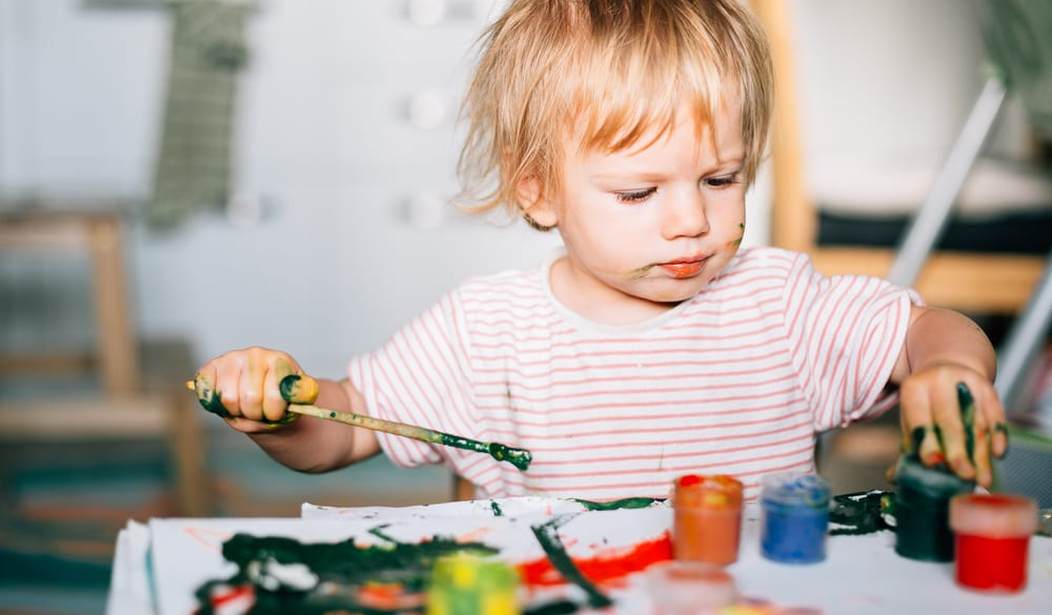Have you ever been to a toddler art class? My son would breathe in art supplies and sleep on construction paper if I let him so I’ve been to quite a few. But they all seem to want me to do the project. We’re given a bunch of cut out shapes and told to glue them down in exactly this way so they make exactly this picture. What toddler could do that? Or we have to turn his handprint into an elephant, so his handprint has to go exactly here and these googly eyes have to get stuck on exactly there. You get the idea. This just leaves my son frustrated and me wondering why I’m paying someone money to do my kid’s art project for him.
At home, things are much simpler. An art project in my house is something he can do independently (or with minimal support) and requires very little preparation. Unless it’s someone’s birthday or something, he is never required to make anything specific (because he can’t).
This isn’t to say that we don’t sometimes pull out all the stops and spend an afternoon on a big mom-led project (like making a hat out of paper maché or something). But it is to say that, when my son wants to do some art, there are plenty of things he can try that don’t require a ton of work on my end. Which is always a plus (since his attention span is like 3 minutes long and it takes twice that to set up some of these big projects). Here are a few of our go-to art activities.
1. Painting
So, yes, there’s some mess involved here which means you’re going to need a couple minutes to prep the area you child is working in. But you shouldn’t need more than a little newspaper to cover the table and a smock to cover your kid. If you’re worried about the floor, put an old sheet or a couple trash bags under the table to catch the drips.
Now, let’s be very clear, your child is not going to paint a picture of anything. He’s just going to paint. And be perfectly happy doing it He’s much more likely to become frustrated (and say he’s done after half a minute) if you’re hovering over him trying to show him the “right” way to use the paint brush. (Of course, if by “right” you mean holding it over the paper instead of flinging it around your head, then by all means, step in.)
Some kids love finger painting and will spend the whole time happily up to their elbows in paint. But other kids, like my son, find the feeling of paint on their hands slightly alarming. (I’m with him, by the way. It’s so slimy and squishy and . . .eww.) Anyway, I usually provide a variety of objects to paint with. This also makes it more likely he’ll sit at the table for more than 30 seconds since there are a few different things to explore. Some things that don’t require too much thought include: paint brushes, sponges, washcloths, and the flat sides of cut up veggies.
2. Collage
Remember, this is not about handing him paper eyes, ears, nose, and mouth and asking him to make a face. (That sounds like an art project for you.) This is just about glue and things to stick with it. We use a glue stick because it’s less messy than Elmer’s. (My son also finds putting the cap on and taking it off again to be an entertaining interlude if he needs a quick break from actually gluing things.) But you can use whichever kind of glue you want.
Rip up some construction paper, old wrapping paper, or tissue paper and let him get to work. If you want, you can cut pictures out of magazines and add that to the mix. My son likes talking about what the pictures are of and deciding which picture to put on next. But, if that sounds like too much extra work, don’t worry about it.
The first few times, your child may need a little tutorial about how to hold a glue stick so the glue gets on the paper, how to stick something onto the glue, and how to make sure there’s enough glue on something so it’ll stick. But after that, he should be pretty independent.
3. Play-Doh
This one is awesome because, unless it gets ground into a rug or something, play-doh is no-mess. It doesn’t make anyone’s hands sticky or stained and it comes right off the table when it’s time to put it away. I know that making your own play-doh is a thing and, if you’re up for it, be my guest. But I buy it from the store and it hasn’t harmed us any.
We also bought a tub of tools to use with our play-doh but they’re definitely not necessary. Blunt pencils, cookie cutters, pipe-cleaners and other household objects work just as well. There’s no goal here. Just let your child play with the dough, squishing it, molding it and poking it. Remember, he’s not going to make a sculpture of anything. He might enjoy it if you do, but then, chances are, you’ll have to stay there with him making more and more sculptures. So I’d just let him be.
4. Stickers
The one caveat here is that your kid has to have the manual dexterity to get the stickers off the sheet himself in order for this to be an independent activity. Until recently mine wasn’t, so this was something we’d do together. But now that he’s figured out the whole fold-the-sheet-’til-the-sticker-pops-up trick, he’s on his own.
Stickers may seem pointless to you (he’s not making anything!) but they’re great fun to him. They make absolutely no mess and they feel like an art project to him. Just let him pull them off the sheet and stick them on the paper wherever he wants. Even one on top of the other. (My son’s sticker projects tend to look like a twenty car pile-up with a few firefighters and construction workers mixed in. Sorry guys.)
If he’s particularly into stickers, you might invest in a sticker book so you can reuse the stickers and don’t have to buy more. But that does mean you’re more likely to find stickers on the floor, walls and tables as they have more of a tendency to fall out of the book if they’re not firmly stuck down.
*
Well, if you try these out a couple times, your kid might become independent enough for you to sit down with a cup of tea and a cookie. Wait, who am I kidding? That would never happen. But, you might at least get to sit down.









Join the conversation as a VIP Member